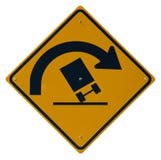When I was running the roads for my Uncle, I chanced upon I-10 out near Orange, TX. There is a sharp curve there with a sign like this. Unfortunately, the 1985 Astro Van (it was a roach motel and had no room for my legs) decided to puke the power steering belt a hundred miles before that sign. It was somewhat manageable if I kept my speed down. A good friend once told me the easiest way to maintain a safe following distance is to never exceed the speed limit. That worked on that trip!
Hitting that curve though? Man alive. I had my four way flashers on, limping on the shoulder, and I had to yank that wheel to get it to move. Too many u-joints in the steering gear for Armstrong steering. Then, I had to yank it back to straighten out. I did a very good physical rendition of a integral on a function. Lots of tiny straight segments that approximated a smooth curve. Well after midnight return on that trip. Side note: the last time I used that van, transmission shelled out on it just east of Austin on 290. Second gear, 40 mph all the way to Hobby Field. I drove it as fast as I dared. It was TOAST when I got there. Good riddance to bad rubbish.
The Mod
This eBook is for the use of anyone anywhere in the United States and
most other parts of the world at no cost and with almost no
restrictions whatsoever. You may copy it, give it away or re-use it
under the terms of the Project Gutenberg License included with this
eBook or online at www.gutenberg.org. If you are not located in the
United States, you'll have to check the laws of the country where you
are located before using this ebook.


I poured a foundation for a plasma cutter in a shipyard that was converted to a railcar repair facility. If I remember, the tank was around 50 feet by 100 feet. To save money, they used an existing foundation for one side of the foundation. Unfortunately, the existing foundation suffered from a long sway due to the sag in the string line, when it was poured. The tiny difference required us to place grout under the tank.
ReplyDeleteI never day them use it, but saw it had a lot of use, when I saw how much slag was in the bottom of the tank.
I drove that section of I-10 for decades. It's all different, and when the new 6 lane highway is complete, will be much safer.
My first foray with one was about the same size up in Longview. I worked for a company that had NC tables running paper tape. I got to move those over to 3.5 inch floppies and spent a bunch of time down there learning.
DeleteThis plasma table (5' x 10') had six inches of slag in the bottom and the slats were so caked, it held everything in waves. I'm working on the replacement parts now.
I don't know much about plasma cutting, but everything I read said it should handle unevenness okay. But this one kept diving into the work. More study showed that water in the air causes the voltage to increase so I mentioned a dryer to the owner. He called his buddy in California and was told it ain't no problem. So we kept diving into the work, damaging the torch. I kept digging, and it kept coming back wet air. I called the developers and they explained it. This doesn't measure voltage on the fly, it has a lookup table. If the voltage is off, the software thinks that the torch is too high and drives it into the work. The model torch it has is notoriously RF noisy, shielding is impossible and that overwhelms the voltage sensing so they don't use it.
I found a HF dryer for 500 or so that can keep up with the air demand. Here's hoping we can get it running without having to babysit it. I have to stare at the arc and if it starts to disappear, I pause and resume the code. It'll touch off and reset the values.
I've read about grouting in machines, but never done any.
I haven't been back to Orange since 2012. Had to go to Sleezeville, LA and pickup up a feldwebel. Seems like a year or two ago. Almost 10 years now.
Amazing what we have done, and what we have seen, ain't it?
Make hay while the sun is shining man.
ReplyDeleteYou know it! Leverage every opportunity. Thanks for the encouragement.
Delete